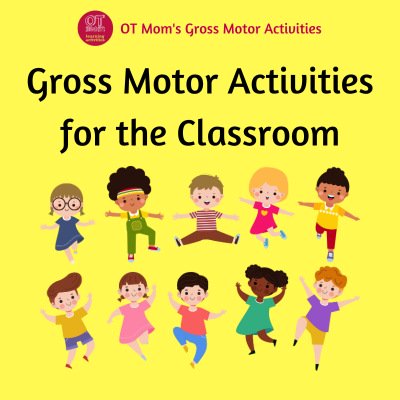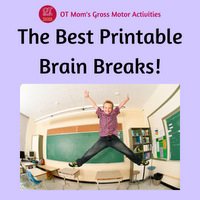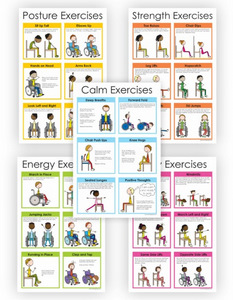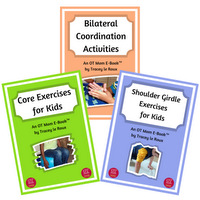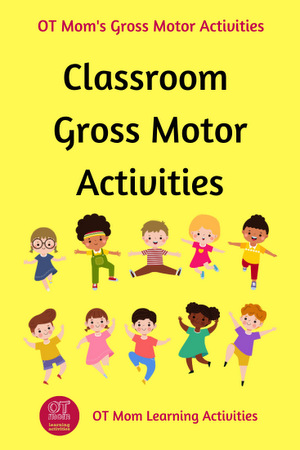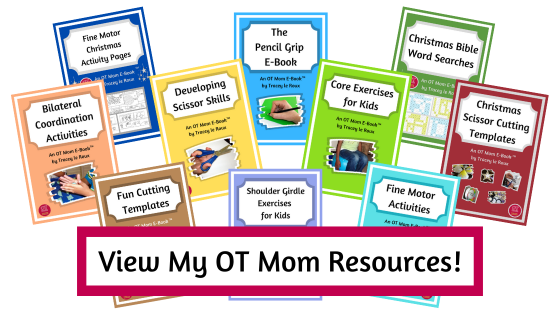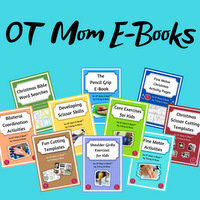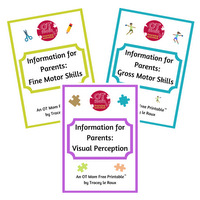- Home Page
- Gross Motor Activities
- Classroom Gross Motor Activities
Classroom Gross Motor Activities
Did you know that classroom gross motor activities can make a world of difference to your students and boost their learning and concentration?
There are many studies which highlight how movement breaks and physical activity can positively impact academic performance, specifically math, language and memory.
Many teachers already use physical activities like jumping jacks and running in place - but you can take it one step further by focusing specifically on vestibular and bilateral movements. These have been specifically linked to improved academic performance. Read this research
I sometimes link to products (#Ad) that are similar to those I use and love. If you do purchase something through my links, I will receive a small commission that helps support my site - thank you!
Help a fidgety child focus with these quick, effective gross motor exercises, ideal for brain breaks, transitions or indoor recess!
Vestibular Activities for the Classroom
Vestibular activities stimulate the receptors in the inner ear, which affect balance, coordination, focus and self-regulation. To get vestibular input, the head needs to move, and these activities will do just that!
The following suggestions are easy classroom gross motor activities and can be done anytime.
1) Picking Up... and Up... and Up!
Have each student place 10 items of stationery on the floor (pencils, erasers etc) and then bend down to pick them up one by one.
The up-and-down head movements provide vestibular stimulation.
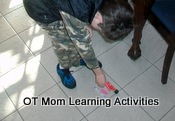 Picking Up Stationery
Picking Up StationeryIncrease the challenge by clapping a rhythm for students to follow, which helps improve timing and sequencing skills.
2) Heads, Shoulders, Knees and Toes!
This is a classic action song that gives lots of vestibular stimulation. It also makes a great gross motor warm-up activity!
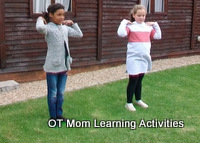 Shoulders!
Shoulders!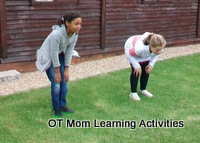 Knees!
Knees!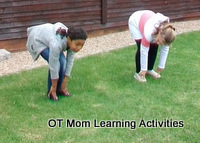 And Toes!
And Toes!Encourage the students to tilt their heads all the way down as they bend, in order to maximize the benefit.
In the pictures shown, the child on the left is looking up, and therefore not getting as much vestibular stimulation as she could be.
3) Recess Activities
Encourage swinging, spinning on roundabouts, twirling and rolling during recess, where safe and appropriate. If trampolines are available, these also give lots of vestibular input.
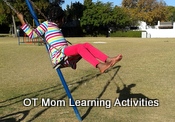 Swinging
Swinging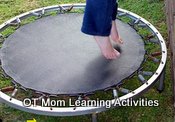 Jumping
Jumping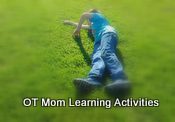 Rolling
RollingImportant note: Some children experience over-sensitivity to vestibular input. Stop the activity immediately if your child becomes fearful, nauseous, pale or sweaty, and consult a health professional.
You can get more information on vestibular processing from these helpful books on sensory processing.
Bilateral Classroom Exercises
Activities that use both sides of the body together (bilateral coordination) have been linked to improved academic performance such as cognitive functioning, paying attention, and even reading, writing and math.
1) Jumping Jacks (Star Jumps)
Jumping jacks can be done on the spot, so they are space efficient as well as effective. They make a great, quick bilateral break between lessons.
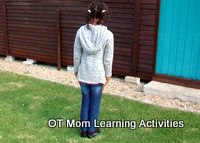 Starting Jumping Jacks
Starting Jumping Jacks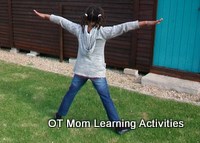 Jumping Jacks
Jumping JacksIf an early elementary child struggles to coordinate these movements, or can't do more then 2 or three at a time, consider referring them for an occupational therapy evaluation.
2) Marching On The Spot
Marching in place, swinging the arms in coordination with the legs, is simple but beneficial.
Vary the activity by doing:
- high marches (lifting knees up as high as you can)
- quiet marches
- stomping marches
- animal-themed marches
Increase the challenge by having everyone march to a beat, or to a marching song.
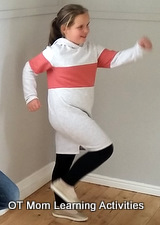 March on the spot
March on the spot3) Keep the Beat
Teachers can clap out a rhythm that students imitate on their desks - this can help improve timing and coordination skills.
Incorporate symmetrical (both hands together) and reciprocal (one hand at a time) rhythms for students to imitate, as well as crossing-over movements.
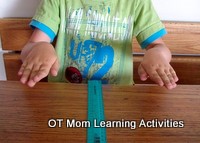 Symmetrical Beats
Symmetrical Beats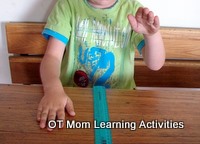 Reciprocal Beats
Reciprocal BeatsOld-fashioned clapping games (eg Miss Mary Mack, A Sailor Went To Sea Sea Sea) are also quick and easy bilateral activities that can easily be done in class.
- Read more about bilateral coordination here!
- Or get more bilateral exercises in my Bilateral Coordination Activities Resource now!
Adapting Activities For Children With Special Needs
Make sure no child is left out! If children have limited mobility or special needs, they can still be included with some adaptations:
- Picking Up: use larger, lightweight objects which are easier to grasp, reduce the number of repetitions, allow children to choose whether to reach from a seated or a standing position, or have then pick up from a seat instead of all the way from the floor.
- Head, Shoulders, Knees and Toes: seated participation is possible for this song, and partial movement can also work.
- Jumping Jacks: modify to stepping jacks and/or arm movements only
- Marching: Allow seated marches, or focus on arm movements. Students can also tap their feet and/or hands to the rhythm.
- Keep the Beat: encourage tapping and/or use of adaptive switches or instruments to keep the beat when a child has limited arm and hand movements.
A school-based occupational therapist should be able to help you with any further adaptations needed.
Classroom Gross Motor Activities: Resources
1) My Favorite Brain Breaks
I have reviewed my favorite brain breaks: there are a variety of digital, poster or printable brain breaks to suit any classroom!
- Perfect for indoor recess activities or homeschool classrooms.
- Print and cut out the cards, and store them in a handy container - pull one out when needed.
- Or make use of the digital downloads for an easy-to-follow video.
2) Printable Chair Exercises - Inclusive Exercises For All Kids
My talented therapist friend over at Your Therapy Source has made it easy for kids to do exercises in their chairs - whether in regular chairs or in wheelchairs!
These chair exercises are great brain breaks to help kids get their focus back during long lessons.
You can choose from:
- Posture Exercises
- Strength Exercises (arms, core muscles and legs)
- Energy Exercises to get the blood moving
- Body Exercises to improve coordination skills
- Calm Exercises to help kids get their focus back
Available in:
- printed format#Ad (5 color posters, PRIME delivery in the USA) or
- digital bundle#Ad (posters, full page versions, and exercise cards - in black and white or color).
3) Exercises With A Specific Gross Motor Skill Focus
My gross motor resources will give you access to dozens of easy activities that can be done at home or at school.
- Focus on a specific skill: core strength, shoulder girdle stability or bilateral coordination skills
- Accessible, reusable and oh-so-doable!
Incorporating these classroom gross motor activities into your daily school routine can make a big difference to your students' focus, concentration and academic performance.
These vestibular and bilateral activities can be easily adapted to the needs of your students and your classroom.
Have fun while you help your kids to love learning!
- Home Page
- Gross Motor Activities
- Classroom Gross Motor Activities
Share this page to help others!
References
All links open in a new tab/window.
- Buchele Harris, H.; Cortina, K.; Templin, T.; Colabianchi, N. and Chen, W. (2018). Impact of Coordinated-Bilateral Physical Activities on Attention and Concentration in School-Aged Children. BioMed Research International. 2018. 1-7. https://dx.doi.org/10.1155/2018/2539748
- Lane, S.; Mailloux, Z.; Schoen, S.; Bundy, A.; May-Benson, T.; Parham, L.; Roley, S. and Schaaf, R. (2019). Neural Foundations of Ayres Sensory Integration®. Brain Sciences. 9. 153. https://dx.doi.org/10.3390/brainsci9070153.
- Pacheco, S.; Gabbard, C.; Ries, L. and Bobbio, T. (2016). Relationship Between Interlimb Coordination
and Academic Performance In Elementary School Children. Pediatrics International.
58. https://dx.doi.org/10.1111/ped.12972
- Wong, T.P.S.; Leung, E.Y.W.; Poon, C.Y.C.; Leung, C.Y.F. and Lau, B.P.H. (2013). Balance performance in children with unilateral and bilateral severe-to-profound-grade hearing impairment. Hong Kong Physiotherapy Journal. 31. 81–87. https://dx.doi.org/10.1016/j.hkpj.2013.07.001
Didn't find what you were looking for? Try a search of my site!
